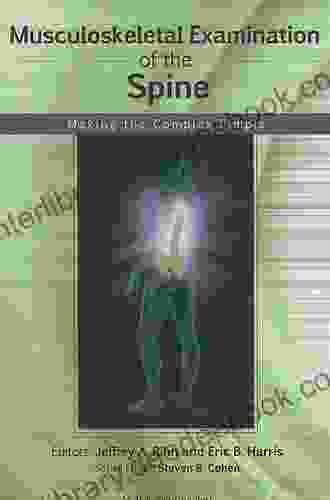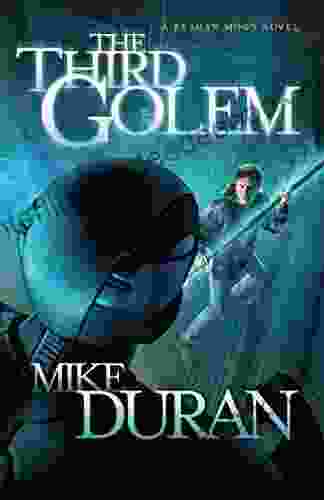Musculoskeletal Examination of the Spine: A Comprehensive Guide for Healthcare Professionals

Musculoskeletal examination of the spine is an important part of physical diagnosis and treatment planning for patients with back pain and other spinal conditions. By performing a thorough musculoskeletal examination, healthcare professionals can identify areas of pain and dysfunction, assess the patient's range of motion and flexibility, and rule out any underlying medical conditions that may be contributing to the patient's symptoms.
4.6 out of 5
| Language | : | English |
| File size | : | 11692 KB |
| Text-to-Speech | : | Enabled |
| Screen Reader | : | Supported |
| Enhanced typesetting | : | Enabled |
| Print length | : | 336 pages |
| X-Ray for textbooks | : | Enabled |
History and Physical Examination
The initial step in the musculoskeletal examination of the spine is to take a thorough history of the patient's symptoms. This should include questions about the onset, duration, and severity of the pain, as well as any associated symptoms such as numbness, tingling, or weakness. The healthcare professional should also ask about the patient's past medical history, including any previous injuries or surgeries to the spine.
The physical examination should begin with a general inspection of the patient's posture and gait. The healthcare professional should observe the patient's standing and sitting posture, as well as their range of motion when walking or bending over. The healthcare professional should also palpate the spine for any areas of tenderness or swelling.
Range of Motion and Flexibility Testing
The next step in the musculoskeletal examination is to test the patient's range of motion and flexibility. This can be done by asking the patient to perform a series of movements, such as forward flexion, extension, lateral flexion, and rotation. The healthcare professional should measure the patient's range of motion using a goniometer or inclinometer.
Flexibility testing can be performed using a variety of methods, such as the sit-and-reach test or the Schober test. These tests measure the patient's ability to bend forward and touch their toes or reach their hands towards their feet.
Neurological Examination
The neurological examination is an important part of the musculoskeletal examination of the spine. This examination can help to rule out any underlying neurological conditions that may be contributing to the patient's symptoms. The neurological examination should include tests of sensation, motor function, and reflexes.
Sensation testing can be performed by using a variety of methods, such as pinprick, light touch, and temperature. Motor function testing can be performed by asking the patient to perform a series of movements, such as walking, hopping, and jumping. Reflex testing can be performed by tapping on specific tendons or muscles to elicit a reflex response.
Special Tests
In addition to the standard musculoskeletal examination, there are a number of special tests that can be used to evaluate the spine. These tests can help to identify specific areas of dysfunction or pathology. Some of the most common special tests include:
- Spurling's test: This test is used to evaluate the cervical spine for nerve root compression. The test is performed by having the patient sit with their head turned to one side and their chin tucked into their chest. The healthcare professional then applies gentle pressure to the patient's head, while observing for any signs of pain or radicular symptoms.
- Lasegue's test: This test is used to evaluate the lumbar spine for nerve root compression. The test is performed by having the patient lie supine with their legs extended. The healthcare professional then lifts the patient's leg straight up, while observing for any signs of pain or radicular symptoms.
- Patrick's test: This test is used to evaluate the hip for sacroiliac joint dysfunction. The test is performed by having the patient lie supine with their legs extended. The healthcare professional then flexes the patient's hip and knee on one side, while observing for any signs of pain or dysfunction.
Imaging Studies
In some cases, imaging studies may be necessary to further evaluate the spine. These studies can help to identify areas of structural abnormality, such as herniated discs, spinal stenosis, or fractures. Common imaging studies used to evaluate the spine include:
- X-rays: X-rays are a simple and inexpensive way to visualize the bony structures of the spine. However, X-rays cannot visualize soft tissues, such as herniated discs or spinal stenosis.
- Computed tomography (CT) scans: CT scans use X-rays and computers to create detailed cross-sectional images of the spine. CT scans can visualize both bony and soft tissues, making them useful for evaluating conditions such as herniated discs and spinal stenosis.
- Magnetic resonance imaging (MRI) scans: MRI scans use magnets and radio waves to create detailed images of the spine. MRI scans can visualize both bony and soft tissues, making them useful for evaluating conditions such as herniated discs, spinal stenosis, and spinal cord tumors.
Musculoskeletal examination of the spine is an important part of physical diagnosis and treatment planning for patients with back pain and other spinal conditions. By performing a thorough musculoskeletal examination, healthcare professionals can identify areas of pain and dysfunction, assess the patient's range of motion and flexibility, and rule out
4.6 out of 5
| Language | : | English |
| File size | : | 11692 KB |
| Text-to-Speech | : | Enabled |
| Screen Reader | : | Supported |
| Enhanced typesetting | : | Enabled |
| Print length | : | 336 pages |
| X-Ray for textbooks | : | Enabled |
Do you want to contribute by writing guest posts on this blog?
Please contact us and send us a resume of previous articles that you have written.
 Novel
Novel Page
Page Chapter
Chapter Text
Text Story
Story Reader
Reader Library
Library E-book
E-book Paragraph
Paragraph Bookmark
Bookmark Glossary
Glossary Bibliography
Bibliography Preface
Preface Synopsis
Synopsis Scroll
Scroll Codex
Codex Bestseller
Bestseller Classics
Classics Library card
Library card Narrative
Narrative Biography
Biography Autobiography
Autobiography Encyclopedia
Encyclopedia Narrator
Narrator Resolution
Resolution Catalog
Catalog Card Catalog
Card Catalog Borrowing
Borrowing Periodicals
Periodicals Study
Study Research
Research Reserve
Reserve Journals
Journals Rare Books
Rare Books Interlibrary
Interlibrary Literacy
Literacy Thesis
Thesis Reading List
Reading List Book Club
Book Club Theory
Theory Fiona Stapley
Fiona Stapley Michael M Franz
Michael M Franz Wendy Dranfield
Wendy Dranfield Michelle Griep
Michelle Griep Rowan Mccandless
Rowan Mccandless Mary H Rubin
Mary H Rubin Beth Luey
Beth Luey Kim Stafford
Kim Stafford A C Drexel
A C Drexel Hannibal Tabu
Hannibal Tabu A N Myers
A N Myers Taylor David
Taylor David Matthew Cordell
Matthew Cordell Ahmet Zappa
Ahmet Zappa Tayari Jones
Tayari Jones Stacey Hall
Stacey Hall David W Rupp
David W Rupp Alice Raine
Alice Raine Eryn Carpenter
Eryn Carpenter Gian Paolo Marcolongo
Gian Paolo Marcolongo
Light bulbAdvertise smarter! Our strategic ad space ensures maximum exposure. Reserve your spot today!

 Harry CookLessons in Leadership: Exploring the Essential Attributes and Strategies for...
Harry CookLessons in Leadership: Exploring the Essential Attributes and Strategies for... Alex FosterFollow ·7.9k
Alex FosterFollow ·7.9k Corey HayesFollow ·2.7k
Corey HayesFollow ·2.7k Steven HayesFollow ·6.7k
Steven HayesFollow ·6.7k Jonathan HayesFollow ·13.7k
Jonathan HayesFollow ·13.7k Lucas ReedFollow ·3.5k
Lucas ReedFollow ·3.5k Floyd RichardsonFollow ·7.7k
Floyd RichardsonFollow ·7.7k Ike BellFollow ·19k
Ike BellFollow ·19k Aleksandr PushkinFollow ·13.3k
Aleksandr PushkinFollow ·13.3k

 Bo Cox
Bo CoxDiscover the Enchanting Allure of Collingwood, Ontario,...
Nestled amidst the breathtaking landscape of...

 Ralph Ellison
Ralph EllisonThe Street of Clocks Poems: A Poetic Journey Through Time
Welcome to The Street...

 Dwight Blair
Dwight BlairCritical Political Economy of the Middle East and North...
The Middle East and...

 Deion Simmons
Deion SimmonsPerfect Strategies For Painting Amazing Marine Creatures...
Gouache is a...

 Hugh Bell
Hugh BellThe American Republic: Constitution, Tendencies, and...
The American Republic,...
4.6 out of 5
| Language | : | English |
| File size | : | 11692 KB |
| Text-to-Speech | : | Enabled |
| Screen Reader | : | Supported |
| Enhanced typesetting | : | Enabled |
| Print length | : | 336 pages |
| X-Ray for textbooks | : | Enabled |












